“I knew we had all the pictures we needed but I was having a blast and just wanted to keep flying Minifox,” wrote British aviation writer, Dave Unwin. In this article we welcome Dave back to give his description of a fun, highly affordable Part 103-compliant ultralight.
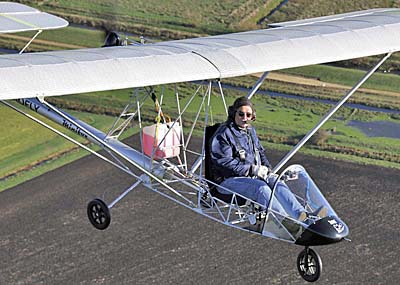
photo by Keith Wilson/SFB Photographic
Minifox by Eurofly is a lot of pure flying fun, and it was just joyful to spend an agreeable afternoon on a well-tended grass strip shooting a series of touch ‘n’ goes in an open-cockpit single-seater.
Upon spotting Minifox at a show I was instantly intrigued and inquired with Dave Broom of Airplay, the UK agent for Eurofly of Italy. Dave told me that a Minifox kit could be completed for less than £19.000 or about $25,000. That’s not a lot of money for a brand-new flying machine, and it occurred to me that such a price could help reverse the current trend of making aviation ever-more expensive. In 1967, a new Cessna 172 cost around $12,750, and a Dodge Charger about $3,100. These days a top-of-the-range Charger is $52,000, but a Skyhawk SP is $307,000!
Eurofly Minifox Pilot Report
Based on Eurofly’s Firefox two seater, Minifox is a ‘pod and boom’ type, mating aluminum tube structure to chromoly steel welded frame.
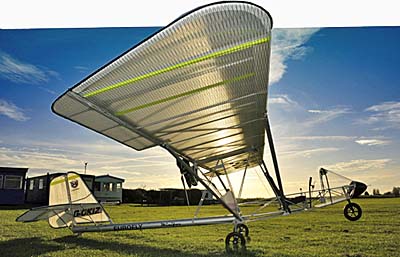
photo by Keith Wilson/SFB Photographic
The ultralight’s high wing is strut-braced and covered with semi-translucent Polyant PX5 trilaminate sailcloth. This modern synthetic material is very robust and UV-resistant.
Dave Broom indicated Minifox is an easy one-man rig incorporating a New Closing Wing System (NCWS) using special brackets to simplify alignment of the wing with the wing attach points. NCWS allows the wings to fold aft and rest on the tailplane in provided wing supports. With wings folded the aircraft is only 7.5 feet wide, towable on most American highways.
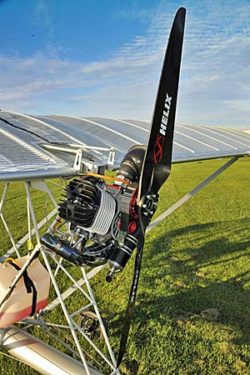
photo by Keith Wilson/SFB Photographic
Eurofly offers several engine options for Minifox. My test aircraft is powered by the engine that Airplay recommends, a Cisco Motors 250 BullMax.
This 230-cc single cylinder two-stroke engine produces 33 horsepower at 7,400 rpm, yet only weighs 36 pounds with electric start. It turns a two-blade composite Helix prop via a Poly Vee-belt. On board fuel is a single four gallon fuel tank behind the seat. Main gear is built from 7075-T6 supporting three identical plastic wheels with solid tires and drum brakes, plus a small fourth wheel underneath the tailplane.
It all appeared very nicely made and I particularly liked the size of the control surfaces offering good control authority. Pushrods drive the ailerons and elevator, with cables for the rudder.
After a careful inspection I was eager to get airborne, and the Minifox looked like it felt the same way!
Aloft in Minifox
The only cockpit adjustment is seat cushions but a builder could fit Minifox to their size. They might also choose an optional fiberglass nosecone with small Lexan windscreen. Another option (though not on the test aircraft) is the Comelli pneumatic airframe parachute.
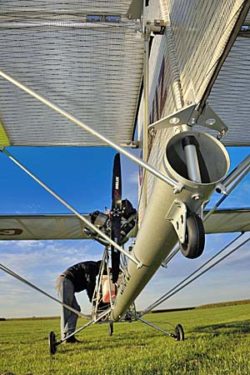
photo by Keith Wilson/SFB Photographic
Once I’ve strapped it on — well, that’s what it feels like; it is literally not that much heavier than me — the controls and instruments are simplicity personified. The primary controls are rudder pedals and a centrally located stick with a handbrake. The throttle is to the left; elevator trimmer on the right. That’s all you need!
Importer Dave obligingly gives the recoil starter a hearty tug and the little engine buzzes busily into life. It is possible to do it when seated, although easier if you’re outside after setting the park brake and chocks. Being a pusher, you’re well clear of the prop.
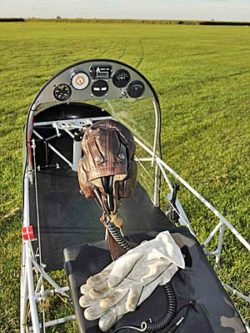
photo by Keith Wilson/SFB Photographic
I found the nosewheel steering worked well and soon I was pointed into a 8-10 knot breeze. As Bullmax “comes on the pipe,” acceleration is really quite good and with just a hint of back pressure Minifox is airborne after a very short ground roll. (Read more about two stroke acceleration in Dave’s full article.)
Doing touch and goes on a quiet, uncontrolled grass field on a sunny day, Minifox is already starting to work its charm on me. In a world of GPS, ADS-B and 8.33 radios, the Minifox is a real throwback to almost the dawn of powered flight.
Minifox is positively stable around all three axes, and the generously proportioned primary flight controls provide excellent control authority, being both powerful and well-harmonized. The roll rate is acceptably brisk, especially if you help it along with judicious application of the powerful rudder.
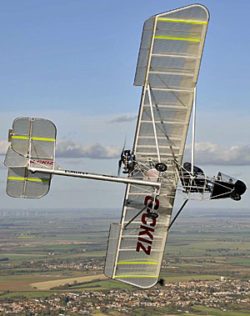
photo by Keith Wilson/SFB Photographic
Minifox offers a field of view nothing short of exceptional. Lacking fuller instrumentation my best guesstimate is that the aircraft climbs between 400 and 500 fpm. Stall characteristics are very benign and slow flight is ridiculously slow, around 22 knots. At the other end the ASI showed 60 knots, however, to reach this velocity, the engine is running 7,400 rpm; a more practical cruise speed is 50-55 knots at 6,500 rpm. At this speed the motor is burning around 1.25 gallons an hour yielding a still-air range of about 125 nautical miles with 30 minutes reserve.
Minifox is available as a complete quick-build kit requiring around 50 hours to complete, or as a RTF (ready-to-fly) aircraft. Importer Dave claims that the kit requires no special skills and can be completed inside a week. From my review, I have to say this seems perfectly reasonable.
After Keith Wilson concludes his detail pictures, we sit outside in the sunshine enjoying a glorious day. Minifox is waiting, its nose pointing expectantly at the perfect sky. It really does seem such a waste for it to be on the ground, and Dave did say that I could have another go if I wanted…
“Hey, Keith, come and give the starter a pull, would you!”
Eurofly Minifox Specifications
- Manufacturer — Eurofly ULM in Vicenza, Italy
- Length — 20 feet
- Height — 6 feet
- Wingspan — 28 feet
- Wing Area — 108 square feet
- Empty weight — 253 pounds
- Max AUW — 507 pounds
- Useful load — 254 pounds
- Wing loading — 4.7 pounds per square foot
- Fuel capacity — 4 gallons
- Never Exceed Speed — 70 knots
- Cruise Speed — 55 knots
- Stall Speed — 22 knots
- Climb Rate — 500 fpm
- Best Glide — 11:1 @ 30 knots
- Min Sink — 400 fpm @ 37 knots
- Take Off to 50ft — 590 feet
- Land Over 50ft — 395 feet
Dave Unwin’s original article contains much more information for those who want to dig deeper. His writing style is also enjoyable and approachable.


Where can I get a Eurofly Minifox? How much is the kit?
Did you try using links in the article and get no response?
Is not it good enough to install a stop on the throttle that is fixed to not be adjusted inflight. Heck, it would limit beating on the motor, too.
Hi Guys:
I’m the North American dealer for Eurofly and the Minifox. In it’s current guise it’s a bit too fast for part-103, but it should be achievable by fitting a smaller engine. The Bull Max is a bit overpowered really.
I’d be happy to work with a sub-dealer or individual customers to get some Minifox aircraft flying in the States.
You can contact me through my website at http://www.airplayaircraft.co.uk
Dave Broom
Hi Dave: Plenty of people enjoyed Dave Unwin’s article about the Minifox. Now they have a way to purchase one. —Dan
I have looked through your website and scoured the internet but have not come across any plans to build this. Is there, perhaps, an older model of this that you’d be willing to sell plans for?
Hi Dave:
Why not sell it in the States as a numbered Experimental, using a bigger engine as the Kolb does with its Firestar, which in essence is a Firefly with larger wings. I just can’t imagine how a 33 horsepower engine can propel it to 65 knots.
Cheers, Mac.
The article says that this Eurofly Minifox is Part-103 compliant. But is it really? I seem to recall reading elsewhere that it’s either too fast or too heavy to make Part 103. Is there a U.S. dealer? Thanks.
Hi Steve: My reference was to the weight and speed. According to Dave Unwin, it appears to fit Part 103, though it may not have been designed to fit that regulation. I am not aware of any U.S. representation. I merely found it an aircraft of interest.
This looks like a fantastic “ultralight”, and it’s something I’ve had my eyes on. However, I seem to recall reading somewhere that while it does meet U.K. “ultralight” requirements, it doesn’t meet U.S. Part 103 requirements. I don’t remember if the issue was weight or speed (or both), but I do distinctly recall being disappointed that it wouldn’t be imported into the U.S. due to lack of Part 103 compliance.
Am I mistaken about this?? And if I am, is there a U.S. distributor? Thanks much for any info you can provide on this topic.
Hi Doug: I have not reviewed this question more deeply. Minifox is certainly close to Part 103 but some parameter could cause it not to qualify. I am not aware of any U.S. representation. Even if does not qualify you have other Part 103 choices.
Thanks, Dan. Upon further review I was able to answer my own question. Because the Minifox is capable of more than 55 knots at full power (the article says it’ll hit 62 knots), it doesn’t quite qualify for Part 103. At least not with its current engine.
Man, there are a few really neat and modern ultralights out there these days (like this Eurofly Minifox, the Ekolot Elf, the Czech Song and the Modern Wings Swan) that come VERY close to Part 103…but don’t quite make it. Usually because of the arbitrary 55 knot restriction.
If I was “President for a day” I’d grant Part 103 an extra 10 knots and 40lbs. That would darn near double the amount of legal ultralights available to us here in the U.S., while potentially making the existing Part 103 fleet even safer. A guy can dream can’t he?? 😉
BTW, thanks for everything you do, Dan. You are a terrific spokesperson for light aviation!
Hi Doug: Changing the prop alone could possibly make the difference but the manufacturer would have to achieve that point. Thanks for your very kind remarks.